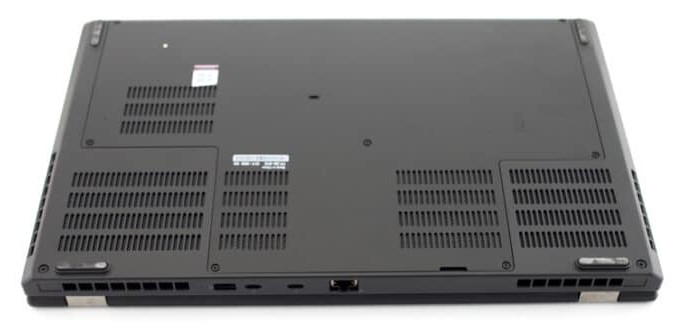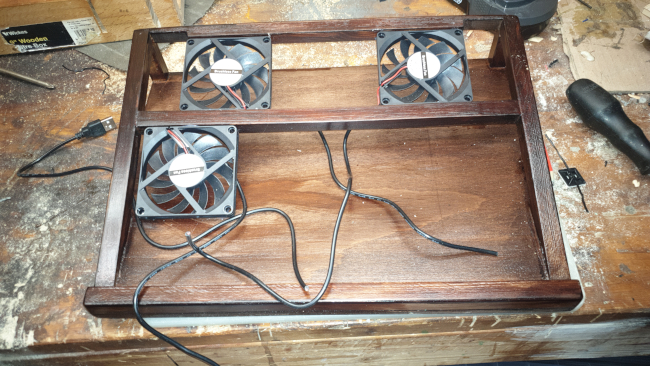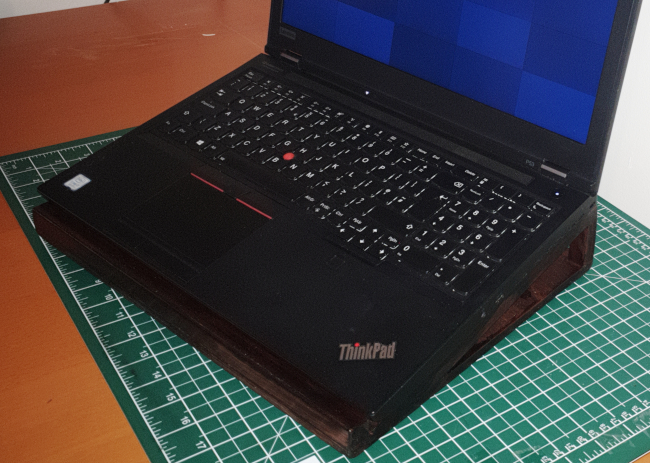A failed experiment in laptop cooling
![]()
I always find it mildly depressing that really powerful laptop computers, that could probably do the work of a desktop, are so limited by their cooling performance. My Lenovo P53 is a case in point. It has an Intel H-class CPU running six cores at 2.6GHz, 32Gb RAM, an NVidia GPU with its own 8Gb RAM, and 5Tb storage. It’s a beast, and should be able to run pretty much anything I need to run.
For cooling, it has separate, massive heatsinks and powerful fans for both the CPU and GPU. The fans run up to 4,000 RPM and, at that speed, they sound like a jet engine warming up.
And yet…
On full load, it takes less than thirty seconds for the CPU temperature to reach 90°C, at which point various protective mechanisms kick in to throttle it. The CPU fan is already running at full speed by this point, and the temperature won’t go down until the load does. This laptop has had its cooling system completely overhauled, so this behaviour doesn’t represent a fault. In fact, the manufacturer tells me that the CPU and GPU are designed to run indefinitely at 90C. With the BIOS in charge of cooling, the CPU fan doesn’t even switch on until its package temperature exceeds 60C.
Maybe the laptop can stand it, but I’m not sure I can. Nor can the surface of my desk: the blast of scorching air from the laptop’s exhausts is melting the varnish. The P53 isn’t the only laptop I own that behaves like this: many Thinkpad models do. I also have an old Yoga, which has a mobile-class CPU, and that’s not as bad: it runs at only 80°C on full load.
Of course, for my own peace of mind, and to reduce the fire risk, I can manually throttle the CPU frequency. But what’s the point of having powerful hardware, and then crippling it?
This article is about my attempt to improve the cooling on my Lenovo P53, by making a custom cooling stand with three extra fans. This attempt failed – it didn’t provide any extra cooling at all. I’m writing about it here, in the hope that I can stop other folks making the same mistakes that I made. I learned a lot, and I now have a much clearer idea why the reported results for proprietary cooling stands are so variable. But I don’t have a cooler laptop.
Building the cooling stand
What I wanted to do was to put an extra fan right under each of the P53’s three air intakes (see photo below). The two intakes at the back are for the CPU and GPU, the smaller one on the centre left (of the photo) is for the NVME SSDs.

The SSDs are particularly troublesome to cool because, although they have their own air vents, they aren’t in the main cooling airflow path. So I guess these devices are really only cooled by convection. I reasoned – wrongly, as it turned out – that if I couldn’t improve the CPU/GPU cooling, a bit of extra forced airflow would help the SSDs.
I hacked up my cooling stand from scrap timber. I agonized about the angle of tilt: too little tilt, and air wouldn’t able to get under the extra fans. Too much, and hot air convection wouldn’t work properly: hot air needs to rise. I think I was mistaken on this point but, in any case, I went for a tilt of about 25 degrees, because that’s what most of the proprietary stands do. I didn’t plan on using the stand with the laptop on my lap, but the modest angle of tilt wouldn’t preclude my doing this, should I want to.
With this angle of tilt, I had to use fans of 10mm depth. Any deeper than this, and there wouldn’t be room for them between the stand base and the laptop – not, at least, with the ankle of tilt I chose.
I used 5V fans, so I could run them from the laptop’s USB port. Each fan draws about 0.2A, so three fans is still within the 0.9A limit for USB 3.
The photo below shows the stand under construction. Comparing this with the photo above, you should be able to see that the three fans will line up perfectly with the three air intakes, when the laptop is on the stand. So, whatever other mistakes I made, I don’t think I made the error of not aligning the fans properly.

Here’s what the stand looks like in use. I appreciate that not everybody likes the look of reclaimed oak, but I’m funny like that.

So, does it work?
Broadly speaking, no.
The simple expedient of raising the laptop base above the desktop gives some small improvement. I presume that this alignment reduces the resistance to airflow. After all, the laptop’s feet only raise it a few millimetres above the surface. However, I could have gotten the same effect by propping up the back of the laptop on a book, and saved myself three evenings in the workshop.
Aside from the slight benefit of tilting the laptop, I found the performance of the external fans disappointing. They do provide some cooling: when I disabled the internal fans completely, the external fans dropped the CPU/GPU temperature by a couple of degrees. At high loads, however, the external fans neither reduced the temperatures consistently, nor caused the internal fans to run any slower.
Most disappointing of all, I found that the external fan directly under the SSD slots didn’t significantly reduce the SSD temperatures under load. I had been prepared, to be honest, for the CPU/GPU temperatures not to be improved all that much, but the lack of improvement in the SSD cooling was, frankly, disheartening.
Why doesn’t it work?
A problem with some proprietary laptop coolers is that their fans don’t direct air to the right places or, worse, block the cooling vents completely. I’m sure that isn’t the case with my design: I picked the locations of the fans and their supports very carefully, and it’s clear that the intakes aren’t blocked.
Another possibility is that the fans just don’t create enough pressure. I used slim fans and, although they run at 2,500 RPM, they don’t move all that much air: a gentle draft, not a howling gale.
I’m sure that fans with larger blades would blow harder. These fans would need a separate power supply, I think. Typically they run at 12V, and draw an amp or more – little chance of running these from a USB port.
Such fans, however, would need a much taller stand. They’re typically 25mm tall, and there would need to be, perhaps, another 50mm below them to develop reasonably smooth airflow (I’m guessing here, of course).
As an experiment, I did try taping a really fast 12V fan below each air intake – something I now realize I should have tried before starting construction. The fans I used were desktop PC fans, each one capable of cooling a complete computer. Even this didn’t help, even when I held the laptop vertically, so there was no impediment to airflow into the fans.
In the end, I’m not really sure we can just put dissimilar fans in series. If you put a fan that can pump (say) 200 cubic feet per minute (CFM) in series with a fan that can only pump 100 CFM, what is the resulting output? Probably not 300 CFM.
If I put a 1.5V battery in series with a 12V battery, then the combined voltage should, indeed, be 13.5V – but only under conditions of no load. As soon as you start to draw current from such an arrangement, the batteries will start to interfere with one another. In practice, the internal resistance of the smaller battery might be so high that it dominates the behaviour of the series battery pair.
So it is with fans, perhaps: if I put the laptop’s existing, very powerful fans in series with the external, weaker fans, then perhaps the external fans just act as a resistance to the internal fans?
I have to confess that I know little about fluid dynamics, or even about fans. But, intuitively, it seems that putting two unalike fans in series might not give better performance that just one fan. Perhaps it’s like trying to tow a Volkswagen with a Ferrari?
In the end, the cooling performance of the P53 and, I imagine, similar laptops is already very good. They have huge heatsinks and very powerful fans. The fact that they run so hot may simply be a deliberate design choice. Perhaps the only way to improve cooling – unless you want to resort to liquid cooling – is to use external fans that can generate an enormous pressure, many times greater than that of the internal fans.
I’ve read reports that proprietary laptop coolers work, and that they don’t. I guess that for some laptops, used in some kinds of ways, they might help. I tried running my laptop in many different conditions of load, and in no circumstances did my custom cooling stand reduce the temperature or increase performance. I’m not convinced that any commercial alternative would do any better.
Closing remarks
There’s something to be said for raising a laptop so that its air intakes are above the surface it’s placed on. It’s probably worth buying or constructing a stand just for this: it might make a difference of perhaps 10°C at modest loads. On its own, though, this modification doesn’t do much at high loads: at full load my P53’s CPU runs at ~90°C, regardless of the cooling, regardless of positioning. It never runs any hotter than that, which I presume is because that’s the point at which it’s throttled.
It’s worth bearing in mind that it’s not all that easy to assess the performance of a cooling accessory. It will interact in complicated ways with the laptop’s own cooling system, which will include its own fans and throttling mechanisms. It’s at least possible that some reports of improved cooling might just result from increased throttling, for some reason.
Moreover, tests of cooling aren’t always consistent. If I apply load in bursts of, say, thirty seconds, the effect on temperature can vary considerably from one test run to the next. Ideally, you need to run tests for minutes to hours, collecting data about throttling and throughput as well as temperature.
Even taking all these factors into account, I’m reasonably confident that additional cooling didn’t benefit my P53 laptop. For others, I guess you’d have to try it and see.
